16 Oklahoma Students Receive Sam Noble Scholarships – 2024
Sam Noble Scholarships assist undergraduate and graduate students studying agriculture as well as undergraduate students studying technology.
Amie Stearns
on
April 15, 2024
Sam Noble Scholarships assist undergraduate and graduate students studying agriculture as well as undergraduate students studying technology.
Gene Waxman
on
December 8, 2023
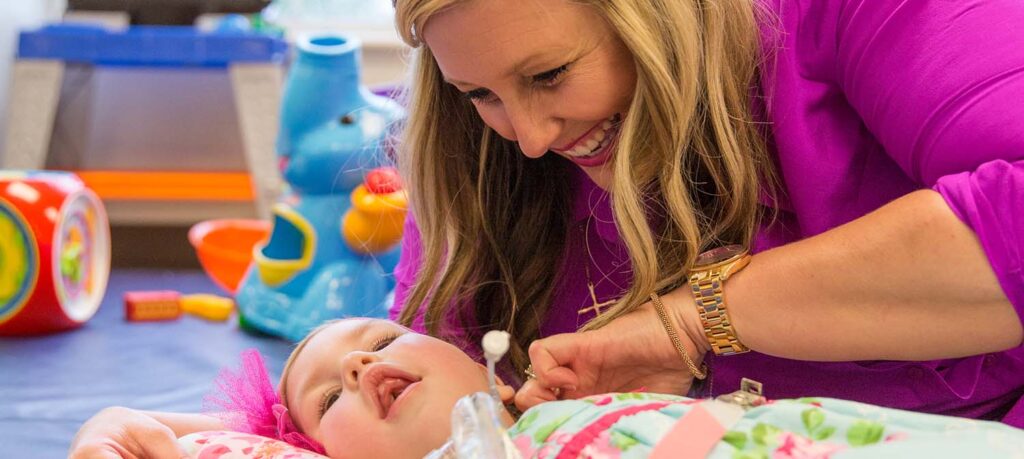
Music drifts from within a care unit at The Children’s Center Rehabilitation Hospital in Bethany, Oklahoma. “The mommies on the bus go shh, shh, shh ….” Sixteen-month-old Kaylee Edgar’s eyes light up, and she smiles from her stroller wheelchair close to her mother, Tarah Edgar.
“She smiles every time,” Edgar said, a smile on her face, too. “You like the momma on the bus, don’t you, Kaylee?” Edgar holds the music maker in her daughter’s lap and leans in close to brush a loose wisp of hair aside and kiss her forehead.
While the music brings joy, Kaylee’s first year of life has been a struggle.
Kaylee was born Jan. 6, 2014, joining the Edgar family — parents, Erik and Tarah, and big sister, 3-year-old Emory — but something was wrong. She was limp and quiet, not what they expected after a normal pregnancy. Kaylee was flown from Stillwater to the University of Oklahoma Medical Center where she spent the next three months. After many tests, doctors finally came to a conclusion. Kaylee has congenital fiber-type disproportion myopathy, a rare condition affecting the muscles that control movement, including breathing.
 Kaylee Edgar, 1, looks up at her mother, Tarah, at The Children’s Center Rehabilitation Hospital. The Edgars are one of many families assisted by nonprofits that receive Noble Foundation grants.
Kaylee Edgar, 1, looks up at her mother, Tarah, at The Children’s Center Rehabilitation Hospital. The Edgars are one of many families assisted by nonprofits that receive Noble Foundation grants.
The Children’s Center Rehabilitation Hospital specializes in caring for children with complex medical disorders like Kaylee’s. In April 2014, she was admitted to their care, and the staff immediately began working to wean her off the ventilator and train the Edgars in her care.
“The first year was rough,” Edgar said, “but we try to stay positive. We can’t imagine what it would have been like if The Children’s Center Rehabilitation Hospital wasn’t here.”
Every day, Edgar drives more than an hour each way to see Kaylee. With training from The Children’s Center Rehabilitation Hospital, the Edgars are able to take Kaylee home for monthly weekend visits, which means being up every three hours. For now, with Kaylee’s critical need for constant care, her corner of the care unit is her home away from home, a pink paradise complete with dozens of hair bows and personal touches.
Just down the hall from Kaylee is a door. Right now, it leads outside. In the future, this door will open to another hallway leading to a four-story expansion, which will include a new education center and 40 additional patient beds. As part of a $30 million expansion, The Children’s Center Rehabilitation Hospital will also renovate existing space into the “Activities of Daily Living Center,” which will train patients to do everyday activities like walking and riding in a car in a simulated “real-world” environment.
A long-time supporter of The Children’s Center Rehabilitation Hospital, the Noble Foundation donated $250,000 toward the expansion. The grant was part of the Noble Foundation’s overall philanthropy effort that awarded $2,379,841 in 2014 through scholarships and grants to nonprofits, including the Ardmore Family YMCA and Boy Scouts of America. “The Children’s Center Rehabilitation Hospital and Noble Foundation have shared goals of making life better for those in our communities,” said Mary Kate Wilson, director of philanthropy, engagement and project management. “This is about Oklahoma helping Oklahoma, and the trustees are pleased to be part of it.”
 Laura Nelson (left) and Raman Saha received scholarships from the Noble Foundation. Scholarships are one part of the organization’s overall philanthropic effort.
Laura Nelson (left) and Raman Saha received scholarships from the Noble Foundation. Scholarships are one part of the organization’s overall philanthropic effort.
$2,379,841 total amount given in 2014 to worthy nonprofit organizations and in scholarships.
The expansion will help The Children’s Center Rehabilitation Hospital serve 33 percent more patients, many of whom, including the Edgars, are from rural Oklahoma. One of the expansion’s highlights is the 24 private rooms, which will help accommodate family time and training. Kaylee shares her care unit with eight to 10 other patients, and patients like her typically stay two years. “This is like her home,” Edgar said. “Being able to have that privacy would be one of the few improvements you could make to such a caring hospital.”
When Kaylee first came to The Children’s Center Rehabilitation Hospital, she was not moving on her own at all. After nearly a year of rehabilitation, surrounded by her family’s love and The Children’s Center Rehabilitation Hospital staff’s support, Kaylee is making progress. “Can you get my hand, Kaylee?” Edgar asked, leaning over to Kaylee lying on a play mat. Edgar wiggles her hand in front of Kaylee’s, and slowly but surely Kaylee reaches her little hand up to touch it. “There’s your proud smile,” Edgar beamed.
Stay up to date on all the ways the Noble Foundation is helping address agricultural challenges and supporting causes that cultivate good health, support education and build stronger communities.
Gene Waxman
on
December 8, 2023
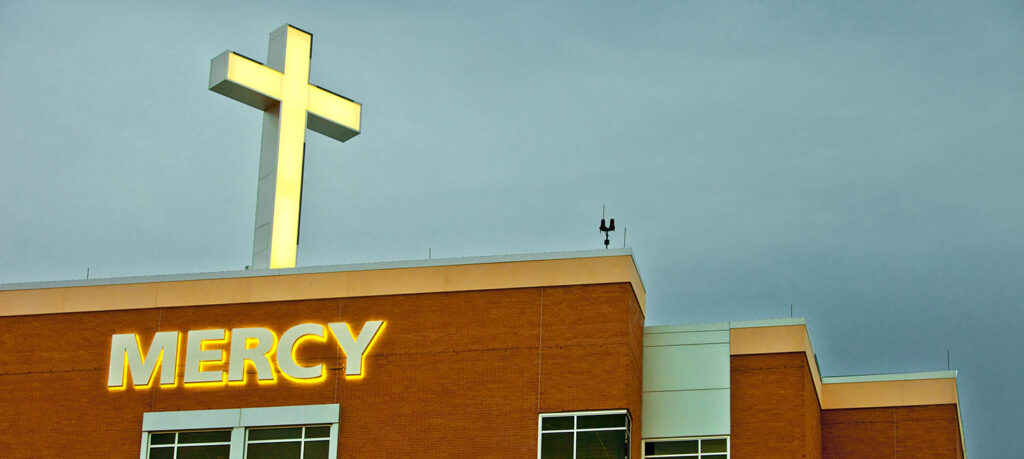
Less than an hour after having his right knee replaced, Billy Simon was wheeled into a room on the fifth floor of the new Mercy Memorial Patient Tower. The 62-year-old patient had spent his fair share of time in the old patient tower as an employee. After a career in the Air Force, the Durant native served 13 years as a licensed practical nurse, even working part-time with the orthopedic group now tending to his knee.
On this day, his eyes darted around his private room, taking in all the details, before settling on a red splash of color. A single rose had been placed on the bedside table by his surgeon with a handwritten note wishing him a speedy recovery. The gesture moved Simon and his wife. “That was pretty special,” he said. “It started off my stay on a good note. I’ve never been given a rose in my life. It made me believe my surgeon and the staff cared.”
Hospital President Mindy Burdick knows gestures like Simon’s rose are not a result of a new facility – compassionate touches have always been a part of Mercy’s ethos. However, the new facility has received universal praise as one of the best in Oklahoma, and patient satisfaction has hit the highest mark in a decade.
On a sunny afternoon six months after the grand opening, Burdick sat in the Women’s Center Waiting Area on the first floor. Sun streamed through the southern bank of windows, and the room was empty save for a single expectant father who was curled up on a row of chairs. Surrounded by empty bottles of soda, the young man had given way to his exhaustion and snoozed quietly. Burdick flashed him a smile. “That’s exactly who this facility is for – anyone and everyone who needs comfort. We could have limped along in the old bed tower,” she said. “But that’s not the level of care that Mercy wants to provide, and it’s not what this community needed or deserved.”
The Noble Foundation’s Board of Trustees agreed. In 2006, the Noble Foundation pledged $7.5 million to the project, roughly one-third of the $22 million in community support needed to jumpstart the $62 million project (the remaining $40 million was provided by the Sisters of Mercy Health System).
 The five-story Mercy Memorial Patient Tower in Ardmore, Okla., opened during summer 2010. The hospital expansion was funded in part by a $7.5 million Noble Foundation grant.
The five-story Mercy Memorial Patient Tower in Ardmore, Okla., opened during summer 2010. The hospital expansion was funded in part by a $7.5 million Noble Foundation grant.
“There is nothing more fundamental to the vitality of a community than its medical care,” said Mary Kate Wilson, director of granting for the Noble Foundation. “The Board of Trustees was eager to support this effort. This one project will impact thousands of lives each year and better this region in a substantial way.”
For Burdick, the Noble grant propelled the project from dream to reality. “Without the Noble Foundation grant, this would not be possible,” she said glancing around the room. “We needed to raise a set amount of funds from the community, and that process would have taken significantly more time without the Noble Foundation.”
The five-story, 180,000-square-foot tower opened in summer 2010, boasting 158 rooms (all private) as well as new intensive care and pediatrics units, a joint replacement center and a women’s center. “The bricks and mortar are absolutely beautiful, but the best part is how every nuance of the new tower is built around the concept of being patient- and family-centered,” said Burdick as she led a tour through the facility. Key to the design are many details – everything from the warm hues of paint to the floral artwork – aimed at making the new hospital tower feel less like a hospital.
Waiting for an elevator, Burdick explained how the building was designed to protect patient privacy. Visitors take separate elevators and flow down their own set of hallways, called “the front staging area” – a term borrowed from Disney theme parks – while patients and staff travel down separate “backstage” corridors. “Patients often feel vulnerable after a procedure. They certainly only want to see their family and friends,” Burdick said. “We want to protect them as much as we can.”
Once on the fifth floor, Burdick entered one of the private rooms (which are larger than the old tower’s shared rooms) and detailed the amenities. Tuscan art slides away to reveal IV pumps and oxygen nozzles; couches fold out into beds for family members; and large posters provide clear directions for the resident.
The changes, however, extend far beyond convenient design and artwork. The new tower offered the Mercy staff an opportunity to implement a revamped model of distributing nurses. Gone are crowded nurses’ stations at the end of the hall that left patients far from support personnel. Decentralized stations locate a few nurses within steps of the six rooms under their care, meaning more one-on-one attention. “Patients seem much more at ease knowing I’m right outside their door,” said Cristi Cole, RN. “They feel connected, and I believe that helps them relax and recover.”
A new phone system increases the nurse-patient connectivity as well. Traditional protocol had patients buzz the nursing station. Now, nurses carry mobile devices that allow constant access. Of course, technology like the phones plays a significant role in the new tower. More than 500 computers support the hospital’s new electronic patient records system (known as EPIC) that went live when the tower welcomed its first patients. EPIC provides the staff a single and comprehensive medical record for each patient. Everyone works from the same virtual chart with the same information. Less paperwork means less opportunity for mistakes.
 Lori Powell, RN, Joint Replacement Center coordinator, examines Billy Simon, a knee replacement patient from Durant, Okla. In addition to 158 private patient rooms, the new facility houses the joint center, intensive care, a pediatrics unit and a women’s health center.
Lori Powell, RN, Joint Replacement Center coordinator, examines Billy Simon, a knee replacement patient from Durant, Okla. In addition to 158 private patient rooms, the new facility houses the joint center, intensive care, a pediatrics unit and a women’s health center.
Each room is equipped with a computer so doctors and nurses can update charts and order tests from the patient’s bedside instead of carrying the information down the hall to be recorded on paper. This trip, Cole explained, often resulted in numerous distractions that slowed down charting. The installation of EPIC also makes Mercy one of only 3 percent of hospitals nationwide to have an integrated electronic health records system that provides real-time, paperless access to patient information. Still, the technology only accents the human element that patients like Simon experience.
After his four-day recovery, Simon offered high praise for the facility and staff. “Beyond staying in the largest private room I’ve ever seen in a hospital, the entire staff treated me and my wife with respect,” he said. “They were careful to guard your dignity. They were truly remarkable.”
Simon specifically recalled one of his initial physical therapy sessions. “The therapist said, ‘Today we’re going to go fishing at the Red River.'” Simon looked down the hall and at the end was a red bucket. Once he had traversed the length of the hall, the physical therapist gave Simon a claw-grabber, which he used to snag a bag of Goldfish crackers from the bucket. “It was a cute and funny exercise,” Simon said. “It made me relax. I appreciated the effort and creativity someone put into setting that up.”
For Burdick, stories like Simon’s are confirmation that her staff and the new tower are offering their best to the community. “I wish that no one ever had to use our services,” she said, “but I want them to have confidence that we deliver superior care here with the express goal of getting them well.”
Stay up to date on all the ways the Noble Foundation is helping address agricultural challenges and supporting causes that cultivate good health, support education and build stronger communities.
Gene Waxman
on
December 8, 2023
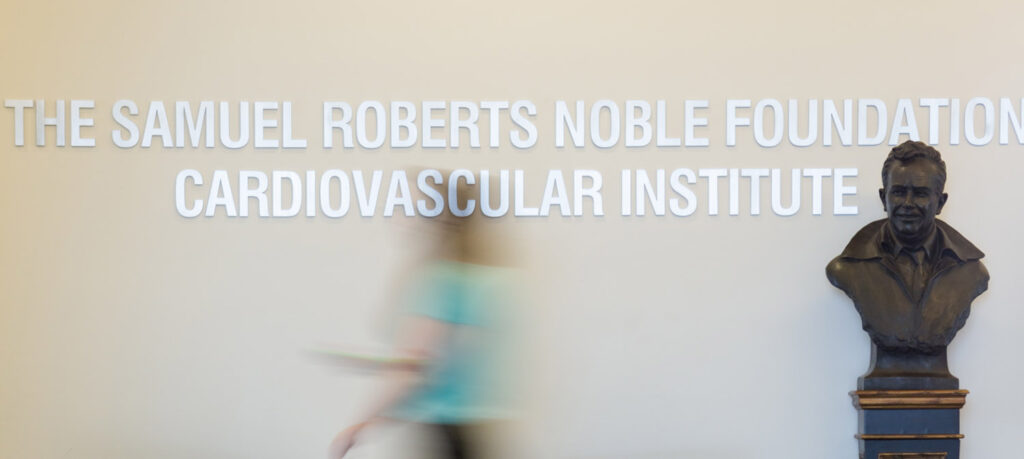

Less than 35 words make up the body of one of the first letters between the Noble Foundation and Oklahoma Medical Research Foundation.
The brief note dates back to July 10, 1970, and it enclosed a $25 donation. The donation, which amounts to about $155 in today’s value, was sent by John March, Noble Foundation president at the time, in response to a request for $25 to help fund the Leonard P. Eliel Lectureship for Endocrinology.
“We hope this will serve in a small way to aid in the success of the lecture series,” wrote March, who had joined OMRF‘s governing board just two months prior.
Forty-five years later, the letter is filed away in the back of a bulky, pale green folder one of five dedicated to The Samuel Roberts Noble Foundation at the medical research institute in Oklahoma City. Though short and simple, the letter marks the beginnings of one of the Noble Foundation’s longest tenured granting relationships.
Since 1977, the Noble Foundation trustees have awarded OMRF more than $19 million to support their researchers’ work in studying ways to fight human disease. The most recent and largest of the gifts was $6 million to support the construction of the Research Tower, which houses The Samuel Roberts Noble Foundation Cardiovascular Institute.
“The Noble Foundation trustees view OMRF as a premier medical research center,” said Mary Kate Wilson, director of philanthropy, engagement and project management. “It brings a certain synergy of research to Oklahoma and increases our state’s profile in terms of benefits to healthcare. They are more of a partner rather than simply a grant recipient.”

(Staff Photos by Rob Mattson/Samuel Roberts Noble Foundation) Mei Cheng, a Research Assistant in the Coagulation Biology lab of Dr. Charles T. Esmon, the Lloyd Noble Chair in Cardiovascular Research at Oklahoma Medical Research Foundation (OMRF), conducts various experiments as part of ongoing research, in Oklahoma City, Okla., Tuesday morning, September 8, 2015.

(Staff Photos by Rob Mattson/Samuel Roberts Noble Foundation) Charles T. Esmon, Ph.D., the Lloyd Noble Chair in Cardiovascular Research at Oklahoma Medical Research Foundation (OMRF), is photographed holding results of a histone H3 experiment as part of blood coagulation research, in the Coagulation Biology Laboratory, inside the Acree-Woodworth building on the OMRF campus in Oklahoma City, Okla., Tuesday morning, September 8, 2015.
Mei Cheng, a research assistant, has worked with Charles Esmon, Ph.D., on blood coagulation research for more than 20 years.
In 1946, OMRF was incorporated by a group of University of Oklahoma Medical School alums. The first research building was dedicated in 1950, and the next two decades of research increased the organization’s credibility through discoveries related to cancer, cardiovascular disease and other debilitating health conditions.
By the mid-1970s, the need for more research space was growing dire. In 1977, the Noble Foundation awarded its first substantial gift to OMRF $500,000 to enlarge and centralize the Laboratory Animal Resource Center. In the early ’80s, OMRF called upon the Noble Foundation for further help. William G. Thurman, M.D. OMRF president, announced the construction date for a cardiovascular research building that would provide 30,000 additional square feet of research space. Before construction could begin, at least 60 percent of the required funds had to be in OMRF‘s hands. This was especially challenging because of the economic climate of the day the 1980s oil bust had spiraled Oklahoma into a devastating recession.
Despite the trying financial times, the Noble Foundation trustees recognized the need for high quality cardiovascular research. In early 1950, Lloyd Noble chaired a fund drive for the Oklahoma Heart Association. In a letter requesting donations, he wrote: “Heart disease is your business and my business, because you, your family and friends are among its potential victims. No one can say with any real assurance, ‘this can’t happen to me’.”
A few days later, on Feb. 14, he unexpectedly died of a heart attack.

(Staff Photos by Rob Mattson/Samuel Roberts Noble Foundation) Dr. Stephen Prescott, President of Oklahoma Medical Research Foundation (OMRF), is photographed during an interview in his office on the OMRF campus in Oklahoma City, Okla., Tuesday morning, September 8, 2015.
Stephen Prescott, M.D., serves the Oklahoma Medical Research Foundation as president.
John Snodgrass had assumed the leadership of the Noble Foundation when the trustees approved $500,000 to be given to OMRF for the cardiovascular research building, which was later named the Acree-Woodworth Cardiovascular Research Building. Snodgrass spoke of Noble’s dedication to service and giving during the building dedication on Sept. 23, 1983, 38 years to the week after Noble founded the Noble Foundation.
He also announced that the trustees wanted to do more than just contribute to the building. In memory of Noble, they established the Lloyd Noble Chair in Cardiovascular Research, a permanent $1 million endowment, and set aside $1.5 million for cardiovascular research operating support over the next five years.
“Although Lloyd Noble’s original gift to the Noble Foundation and his subsequent bequests were substantial, I doubt that even he visualized the size and scope of the good works that he had made possible for mankind,” Snodgrass said during the dedication.

(Staff Photos by Rob Mattson/Samuel Roberts Noble Foundation) Charles T. Esmon, Ph.D., the Lloyd Noble Chair in Cardiovascular Research at Oklahoma Medical Research Foundation (OMRF), is photographed holding results of a histone H3 experiment as part of blood coagulation research, in the Coagulation Biology Laboratory, inside the Acree-Woodworth building on the OMRF campus in Oklahoma City, Okla., Tuesday morning, September 8, 2015.
Charles Esmon, Ph.D., holds the Lloyd Noble Chair in Cardiovascular Research at the Oklahoma Medical Research Foundation.
Across from OMRF is the University of Oklahoma College of Health Building. That’s where Charles Esmon, Ph.D., started his first laboratory after finishing his postdoctoral work at the University of Wisconsin in the mid-1970s.
In the summer of 1982, Esmon joined the OMRF scientific staff and moved his lab into the not-quite-complete Acree-Woodworth Cardiovascular Research Building. The promise it offered was too tempting more space to conduct his research.
In September 2015, Esmon sat in his office just down the hall from the connected cardiovascular research building in its mirror image, The Massman Building and Mary K. Chapman Center for Cancer Research, which was also constructed with Noble Foundation support.
It was a typical Oklahoma summer hot, Esmon recalled. His eyes seemed to search for the past, and he chuckled in remembering it. They rolled their equipment over to the new building in the heat trying not to break anything, he said.
Once they moved in, the building was alive with research nearly 24-7. At one time, one lab member started his day at 10 p.m. and worked through the night in order to have everything prepared for the next day’s experimentation.
Esmon’s lab was, and still is, studying blood and how it clots. Early in his research career, Esmon began studying Protein C, a critical component of blood that prevents it from clotting within the body. One of the benefits of the new lab was a whole room dedicated to the messy process of isolating Protein C from blood cow blood.
It was Oklahoma’s vibrant livestock industry, in part, that had drawn Esmon to the state. Oklahoma City’s beef packing plants kept him supplied with the important research material, which ultimately led his lab to discoveries fundamental to two life-saving therapies: one for a deadly genetic Protein C deficiency; the other for sepsis, a serious illness caused by infection in the blood. The work is also the basis of other research focused on a host of major diseases, from heart and blood diseases to cancer and diabetes.
Over the years, Esmon’s work has earned him many high profile recognitions. He became Oklahoma’s first Howard Hughes Medical Institute Investigator in 1988, and he has received multiple awards from the American Heart Association, the American Society of Hematology, and the International Society of Thrombosis and Hemostasis. In 2002, he was elected to the prestigious National Academy of Sciences.
While agriculture in a way supported his early research, his research is also supported by the Noble Foundation a research organization dedicated to supporting agriculture. In 1996, Esmon was honored as the first Lloyd Noble Chair in Cardiovascular Research, a position he continues to hold.
For Esmon, having the Noble Foundation’s financial support means stability for his lab and not having to rely on short-term governmental grants.
“The Noble Foundation provides tremendous support. Because of them, I can take a longer-term view of research with the people in my lab. That simply would not happen on short-term grants.”
— Charles Esmon, Ph.D.
“Even in the best circumstances, you can get only 75 percent of your funding from grants,” said Stephen Prescott, M.D., OMRF president. “Financial supporters like the Noble Foundation are one of the reasons we’ve been successful as an organization. Historically, if we’ve had a worthy project, the Noble Foundation has been willing to help us.”
Without relying on short-term grants, Esmon has been able to cultivate his lab members, helping them be successful over time. This, he said, has helped him maintain some laboratory members for more than 20 years.
“The Noble Foundation provides tremendous support,” Esmon said. “Because of them, I can take a longer-term view of research with the people in my lab. That simply would not happen on short-term grants.”
At 68 years of age, Esmon continues to build off initial findings. About five years ago, Esmon’s lab discovered a new property of the critical proteins called histones. These proteins are responsible for folding DNA so that it fits inside the cell nucleus. Although histones serve this critical function, when they exit the cell, generally through a traumatic experience like a car accident or gun shot, “They control your demise,” Esmon said. His lab’s current research focuses on using this knowledge to help trauma victims. The research is also instrumental in an experimental treatment for hemophilia being developed.
In the spirit of Lloyd Noble, Esmon said he chose to study blood coagulation because he’d be able to ask interesting basic questions that are relevant to making life better for people.
“The research we’re studying affects all the major killers heart disease, sepsis, cancer,” Esmon said. “You might develop a reagent, test it, then the next thing you know you’ve got a therapy that saves lives. That’s rewarding. That’s what I’m here to do.”
Stay up to date on all the ways the Noble Foundation is helping address agricultural challenges and supporting causes that cultivate good health, support education and build stronger communities.
Gene Waxman
on
December 8, 2023
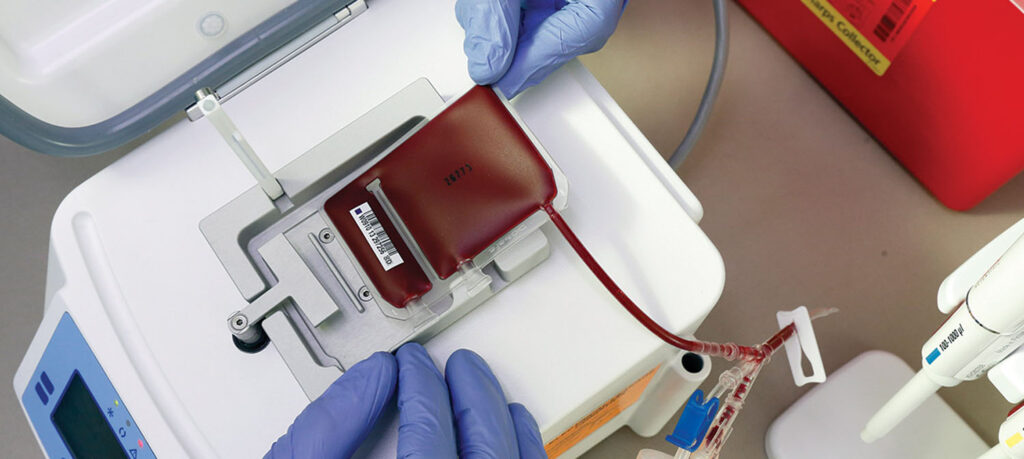

Howie Jackson was just 27 years old when he was diagnosed with acute lymphoblastic leukemia, a form of the disease common in juvenile patients younger than 17 and adults older than 65.
But that was just the beginning of his rare and remarkable story.
Treating leukemia often involves a bone marrow stem cell transplant, which requires a viable donor who is a genetic match (usually found among the patient’s close family members). Jackson, however, was adopted from the Azores Islands, near Portugal, making a family option near impossible.
His future became a game of roulette as he was entered into the National Marrow Donor Program in hopes of finding an unrelated genetic match in time to save his life.
Almost as an afterthought, Jackson’s transplant coordinator requested permission to enter Jackson into a different kind of donor registry the National Cord Blood Program on the slim chance that stem cells harvested from the umbilical cord of a full-term pregnancy would provide the match to save Jackson’s life.
If the search yielded a match, Jackson would make history as the first adult in the state of Oklahoma to receive an umbilical cord blood stem cell transplant.
The odds were not in his favor, and it was a bet he couldn’t afford to lose.
 Oklahoma Blood Institute on Thursday, Jan. 9, 2014, in Oklahoma City, Okla. Photo by Steve Sisney[/caption]
Oklahoma Blood Institute on Thursday, Jan. 9, 2014, in Oklahoma City, Okla. Photo by Steve Sisney[/caption]Photo by Steve Sisney
An Oklahoma Blood Institute employee processes umbilical cord blood donations to preserve potentially lifesaving stem cells.
The National Cord Blood Program is a public bank housing the umbilical cord blood of full-term pregnancies for the purpose of harvesting viable stem cells as matches for patients with blood cancers and other blood disorders, like leukemia or sickle cell anemia.
The umbilical cord is taken after childbirth without harming the child or mother. After collection, cord blood is tested for tissue type and viruses, processed for freezing, and stored until it is needed for transplantation.
Unlike private umbilical cord banks, which collect and save umbilical cords for the specific use of being a match for the individual it was harvested from or for members of the individual’s family, a public bank can be utilized by any eligible patient entered into the registry. So someone of Portuguese descent, like Jackson, could be a genetic match for a donor halfway across the country. Further, public umbilical cord banks are completely free.
“In Oklahoma, prior to our public cord blood bank, the only option for an expectant mother who wanted to utilize her baby’s umbilical cord was to bank it privately,” said Gary Lynch, director of corporate development for the Oklahoma Blood Institute (OBI). “The initial cost to bank privately is between $2,000 and $2,500, then an additional $150 a year after that. All of this without a guarantee that it would be useable for her child or an immediate family member.”
Without a public bank in Oklahoma (the closest option is in Houston, Texas), umbilical cords and the potentially lifesaving stem cells they hold were considered medical waste and thrown away. OBI wanted to change that.

Oklahoma Blood Institute on Thursday, Jan. 9, 2014, in Oklahoma City, Okla. Photo by Steve Sisney
Photo by Steve Sisney
The need for a public umbilical cord blood banking center within Oklahoma is as unique to the state as waving wheat and windy days. Oklahoma has the largest Native American population per capita in the United States, representing an opportunity to grow the national registry to further include and provide matches for minority patients.
“Only 0.2 percent of 1 percent of the national registry is Native American,” Lynch said. “Oklahoma’s Native American population, the largest per capita in the country, is the least represented group. We can add to the diversity of the national registry by leaps and bounds, and in a relatively short period of time.”
OBI set a goal to raise $3 million enough to establish and maintain the public umbilical cord blood banking center for two years. OBI began reaching out to organizations within the state for financial support.
The Noble Foundation reached back with $15,000 to support the center’s creation and operations. The Noble Foundation, a longtime supporter of OBI, has given $790,000 to date in support of the institute and its various missions.
“The Noble Foundation and the Oklahoma Blood Institute share the same goal of advancing Oklahoma and its quality of life,” said Mary Kate Wilson, director of philanthropy, engagement and project management at the Noble Foundation. “In addition to helping Oklahomans, the public bank gives us the opportunity to increase the diversity of the national registry and help people everywhere. We wanted to be a part of this noble cause.”
The center opened in January 2014. OBI will soon complete the rigorous Food and Drug Administration licensure process for the cord blood facility. Additionally, a major portion of OBI‘s original headquarters in Oklahoma City has been renovated to accommodate offices, laboratory and cryogenic storage tanks for the program.
OBI‘s new public umbilical cord blood banking center is one of 17 in the country and 24 worldwide. Mothers giving birth at OU Medical Center can choose to donate their child’s umbilical cord to the state bank. OBI will partner with additional hospitals in the future and eventually collect enough cords to qualify for entry in the national registry. Opening OBI‘s public umbilical cord blood bank and establishing its presence in the national registry is just the beginning; raising awareness, sustaining funding and getting mothers to donate are their greatest challenges.
“Cord blood is being used for treatment of blood disorders, but scientists are beginning trials for diabetes and traumatic brain injuries,” Lynch said. “The future is unlimited.”

Oklahoma Blood Institute on Thursday, Jan. 9, 2014, in Oklahoma City, Okla. Photo by Steve Sisney
Photo by Steve Sisney
Today Howie Jackson is cancer free. He was the first adult in Oklahoma to receive a stem cell transplant from umbilical cord blood after finding six perfect genetic matches in the national donor registry.
He entered into remission.
A year and a week after his successful transplant, his leukemia returned. But because his first transplant was a year earlier, he was eligible to enter the national umbilical cord blood registry again.
Five of the original six genetic matches remained available; thus, Jackson became the first adult in Oklahoma to receive two stem cell transplants from umbilical cord blood.
Because of his success, it is now common practice to use two cord units on adult patients of leukemia.
Today, Jackson often takes his story to Washington, D.C., in hopes of raising awareness and funding opportunities for the American Cancer Society and National Donor Marrow Program. Historically, the national donor program has never been fully funded.
“Our biggest hurdles are manpower, resources and getting this information out to the general public,” Jackson said. “If we keep trying and we spend enough money, we will beat cancer. That’s a promise. I am a man who was cured by God and because people gave money for research.”
The first umbilical cord blood stem cell transplant was successfully completed in France in 1988 on a child diagnosed with a rare blood disorder. The first transplant on an adult was successfully completed in 1997, just a few years before Howie Jackson’s acute lymphoblastic leukemia diagnosis in 2001.
Stay up to date on all the ways the Noble Foundation is helping address agricultural challenges and supporting causes that cultivate good health, support education and build stronger communities.
Gene Waxman
on
December 8, 2023
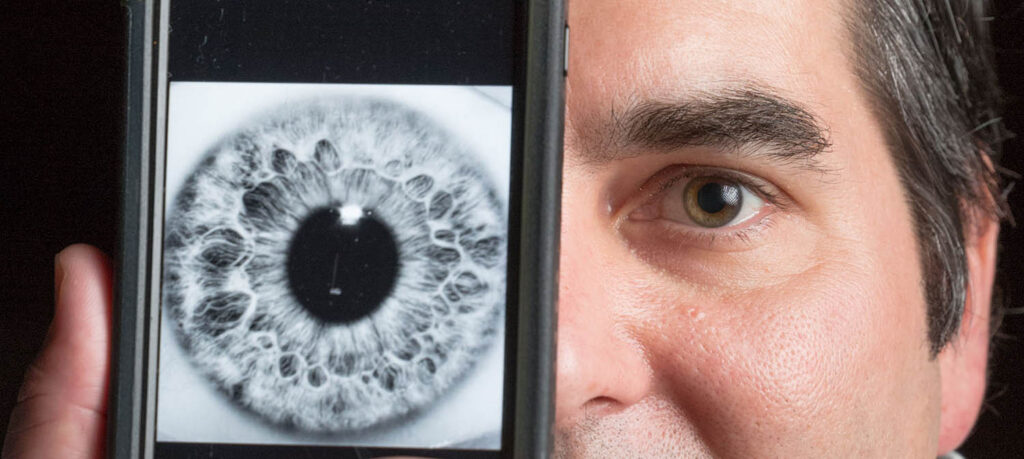
Soft sunlight shines through the glass walls of the Dean McGee Eye Institute (DMEI) in Oklahoma City. As the eye captures light and works with the brain to produce images of the surrounding world, so, in a way, does the Institute.
At DMEI, knowledge is generated through research and clinical trials much like the eye captures light. Instead of producing images, the research brings clarity to methods of preventing and treating eye disease. Just like the eye works with the brain, the Institute people – researchers, clinicians and surgeons – collaborate to help others continue to see the world around them.
In the early 2000s, research at the Dean McGee Eye Institute boomed. More space became a necessity, and a capital campaign was launched. In 2004, the Noble Foundation joined other donors to the campaign with a $1 million gift to help expand the facilities.
The result: these glass walls and the space to accommodate a vibrant world-class vision research program.

(Staff Photos by Rob Mattson/Samuel Roberts Noble Foundation) Michael Elliott, M.D., Ph.D., a physician and researcher who serves as an Assistant Professor, Department of Ophthalmology, Adjunct Assistant Professor, Department of Physiology and Mentoring Faculty, Oklahoma Center for Neuroscience, sits for a portrait at the Dean McGee Eye Institute in Oklahoma City, Okla., Thursday afternoon, February 18, 2016.
The studies of Michael Elliott, Ph.D., a researcher at the Dean McGee Eye Institute in Oklahoma City, have implications for treating vision loss related to diabetes, glaucoma and macular degeneration.
It didn’t take long for Michael Elliott to realize he needed to be in a laboratory with other vision science researchers.
Elliott stumbled upon eye research as a Ph.D. student at the University of Kansas in the 1990s. The laboratory in which he worked studied damage caused by oxidation in parts of the brain. A colleague at the time, who previously worked at the National Eye Institute, told him some of their research could be applied to the retina, the back-inside coating of the eye. Why not take a look, Elliott thought?
The more Elliott studied the eye, the more interested he became in the system and how the eye and brain partner to produce images. The lone eye researcher in the laboratory, Elliott buried himself in papers to learn more. He picked up on researchers’ names through these papers, then met the name bearers at national meetings of the Association for Research in Vision and Ophthalmology.
“It became quite clear to me that if I wanted to stay in this field, I needed to be part of a lab that specifically studies the eye,” Elliott said.
When the time came to apply for postdoctoral fellowships, the Dean McGee Eye Institute was at the top of his list because of a name that kept reappearing in the papers he had studied: Anderson, as in Robert E. “Gene” Anderson, M.D., Ph.D.

(Staff Photos by Rob Mattson/Samuel Roberts Noble Foundation) Michael Elliott, M.D., Ph.D., a physician and researcher who serves as an Assistant Professor, Department of Ophthalmology, Adjunct Assistant Professor, Department of Physiology and Mentoring Faculty, Oklahoma Center for Neuroscience, embarks on a new research protocol with his assistant, which seeks to better understand eye health by studying harvested vascular cross-sections, at the Dean McGee Eye Institute in Oklahoma City, Okla., Thursday afternoon, February 18, 2016.
Michael Elliott, Ph.D., studies retinal cells in laboratory space at the Dean McGee Eye Institute that was made possible through a gift from the Noble Foundation.
Research at the Dean McGee Eye Institute was gaining momentum in the early 2000s, thanks to several significant milestones still in play today, said Anderson, DMEI research director and Elliott’s mentor.
First was a grant from the National Eye Institute that enabled DMEI to provide core research facilities to its research staff.
Then, in 2002, the Institute received the prestigious NIH Centers of Biomedical Research Excellence (CoBRE) grant, which provided$1.5 million per year for 10 years to identify and mentor young researchers in vision science.
Elliott was selected for the program in 2007.
“The program was phenomenally successful,” Anderson said. “It launched the careers of seven young investigators.” All seven are now tenured or on tenure track and have won their own R01 funding, the gold standard in grants from NIH.
There was only one problem: space.
“As we became more successful, we were bursting at the seams,” Anderson said. “We were packed in ‘cheek by jowl.'”
Everyone, from junior to senior level, was sharing laboratory and office space. They were outsourcing clinical activity, which meant the researchers and clinicians couldn’t have a close relationship to connect molecular knowledge with real-world situations.
Though they had the funds and desires to expand research projects and add researchers, they didn’t have the room to accommodate anyone new.
 Robert E. “Gene” Anderson, M.D., Ph.D., research director at the Dean McGee Eye Institute, is known around the world for his vision health research.
Robert E. “Gene” Anderson, M.D., Ph.D., research director at the Dean McGee Eye Institute, is known around the world for his vision health research.
About a hundred miles south, the Noble Foundation had a long history of supporting DMEI. Since 1974, the Noble Foundation has awarded DMEI nearly $3 million in support for research, construction and renovations.
During this new era of growth and need in the 2000s, the Noble Foundation again stepped forward to help, providing its largest gift to date to DMEI: a $1 million contribution toward a facility expansion that doubled research space and expanded clinical programs by 40 percent.
“The Noble Foundation trustees value the Dean McGee Eye Institute’s vital contributions to science and quality of life for those struggling with eye problems,” said Mary Kate Wilson, Noble Foundation director of philanthropy, project management and engagement. “As stewards of a research institution themselves, they understand the importance of quality working facilities and were pleased to support this important project.”
Construction was completed in 2011, and the effect was immediately felt by the researchers. “It was tangibly huge,” Elliott said. “We went from everyone stumbling over each other to having enough space to bring in more people.”
Elliott’s lab space quadrupled, and for the first time he moved into his own office. The CoBRE-funded mentorship program provided him the funds and support he needed to kick-start his retina research, which has implications for understanding the mechanisms behind and treating vision loss from diabetes, glaucoma and macular degeneration. The building expansion provided the space he and the rest of DMEI needed to continue growing into the exciting research possibilities of the future.
“We are deeply grateful to the Noble Foundation,” said Gregory Skuta, M.D., president of the Dean McGee Eye Institute. “Their meaningful and consistent support over the past four decades has allowed us to deliver a profound, lasting impact on vision health.”
Stay up to date on all the ways the Noble Foundation is helping address agricultural challenges and supporting causes that cultivate good health, support education and build stronger communities.
Gene Waxman
on
December 8, 2023

Oklahomans caught in the grips of addiction will find new hope at Arcadia Trails, the state’s first recovery center to simultaneously treat addiction, mental illness and trauma.
Alden Snipes had few treatment options in her home state of Oklahoma when she began her journey to sobriety in 2000.
Snipes’ best hope was in Tuscan, Arizona, more than 1,000 miles away from familiar surroundings and loved ones, including her two small children. It was a difficult time, she recalls. But looking back, she knows she was one of the lucky ones.
“I was fortunate my family could afford it,” says Snipes, who has been sober for 18 years now. “A lot of people cannot.”
In spring 2019, Oklahomans will have a new treatment option: Arcadia Trails Center for Addiction Recovery.
“I really believe the Noble Foundation’s gift created a cascade of momentum for us. When the Noble Foundation stepped forward to stand behind the project at a leadership level, it prompted others to follow suit.”
— Becky Endicott,
INTEGRIS Health Foundation leadership gifts officer
For Snipes, Arcadia Trails is personal. It will feature a comprehensive style of treatment that will increase the chance of long-term sobriety. This treatment looks at healing the whole person not just treating the addiction in isolation. And Snipes says it’s what Oklahoma needs.
Arcadia Trails was the brainchild of four Oklahomans who, in 2011, sought a solution to the state’s addiction problem. More Oklahomans between the ages of 25 and 64 die because of addiction than any other disease. At the same time, the state ranks second-to-last in the nation for treating it.
These visionaries wanted to change the conversation surrounding addiction. They knew that one-size-fits-all treatments rarely result in complete and lasting healing. They also knew Oklahomans needed greater access to affordable and effective treatment.
“Arcardia Trails addresses the whole person with a holistic approach. This is something Oklahoma needs and Oklahomans deserve, and the Board wanted to be part of the solution.”
— Alexis Carter-Black,
director of philanthropy at the Noble Foundation
They took their concept to INTEGRIS, the state’s largest not-for-profit health care system, and INTEGRIS agreed to turn the dream into reality. Upon completion, Arcadia Trails will be a 61,900-square-foot, 40-bed medical treatment center on a wooded lot on the INTEGRIS Health Edmond campus.
Snipes, in addition to being a retired registered nurse and intimately understanding addiction recovery, has been involved in a clinic for recovering opioid addicts. She also served on the committee that wrote the treatment protocol for Arcadia Trails, which will be the first medical facility in the state to offer a whole-person approach to treating addiction.
This treatment model is unique because it equally addresses addiction, mental illness and trauma. Programs will be tailored to each patient’s needs, and patients will move through the 60- to 90-day program at their own pace. Along the way, they will be supported by a blend of experts ranging from dietitians and clergy to psychiatrists, medical doctors and addictionologists.
“This three-pronged approach is why Arcadia Trails will be successful,” Snipes says. “The three are tightly woven together, which makes it difficult to address one without the other. Treating addiction without treating trauma or mental health won’t allow you to be as successful as you would be if you treated all three at one time.”

INTEGRIS donated $11 million to the project then committed to raising the additional $35 million needed by launching a fundraising campaign and uniting Oklahoma communities in battling the statewide crisis.
When the Noble Foundation joined the fight with $100,000 in 2015, it became the third to give and the first major donor outside of Oklahoma City.
“I really believe the Noble Foundation’s gift created a cascade of momentum for us,” says Becky Endicott, INTEGRIS Health Foundation leadership gifts officer. “When the Noble Foundation stepped forward to stand behind the project at a leadership level, it prompted others to follow suit.”
Endicott says the Noble Foundation’s donation also created what her office calls the “Ardmore Effect.”
“Noble’s gift was the first that opened the Ardmore community to the campaign,” Endicott says, of an effort based in Ardmore as a whole.
Ardmore residents and organizations, led by the Noble Foundation’s example, opened their checkbooks and donated a total of $1.3 million, action that Endicott describes as people locking arms and saying they want to get behind the new treatment center because it will battle a crisis ravaging their community.
“What is so inspiring to me is that individuals who gave from Ardmore did it in a way that worked for them,” she says.
In addition to financing construction of the facility, which broke ground in October 2017, campaign-raised funds will establish an endowment to provide financial assistance to those who need it. Many of the donations given by Ardmore individuals went to ensure funds are available specifically to residents in their county who need treatment but cannot afford it.
“That level has inspired so many other communities in the state,” Endicott says. “It’s all about us coming together and saying, ‘We are not going to stand by any longer and watch our citizens die. We’re going to take care of our own.’ It’s an amazing rallying cry, and I credit the Noble Foundation and its board members, especially Rusty Noble, for influencing our movement.”

Endicott says one of the most important aspects of the Arcadia Trails project is that it will provide more affordable treatment for all Oklahomans. And, its service area may extend outside the state. While the U.S. has other treatment centers that use a similar approach, none are located in this region of the country.
Alexis Carter-Black, Noble Foundation director of philanthropy, says this great need and the unique approach is why the Noble Foundation supported the Arcadia Trails project.
“Something of this size and caliber coming to the state of Oklahoma is critical to fostering healthy communities,” Carter-Black says. “Arcadia Trails addresses the whole person with a holistic approach. This is something Oklahoma needs and Oklahomans deserve, and the Board wanted to be part of the solution.”
Snipes also sees Arcadia Trails as a valuable resource for Oklahoma, one she wishes would have been available 18 years ago.
“I know from experience that the local connection is important,” Snipes say. “Not only does it help keep patients linked to their support network at home, it also makes it easier to stay in touch with the treatment support network later on. I also know the type of treatment that Arcadia Trails will provide works. It worked for me, and I know other Oklahomans will benefit from it as well.”

“The newly renovated Ardmore Family YMCA provides community members with more space to stretch their muscles and build life-long friendships.”
Stay up to date on all the ways the Noble Foundation is helping address agricultural challenges and supporting causes that cultivate good health, support education and build stronger communities.
Gene Waxman
on
November 28, 2023
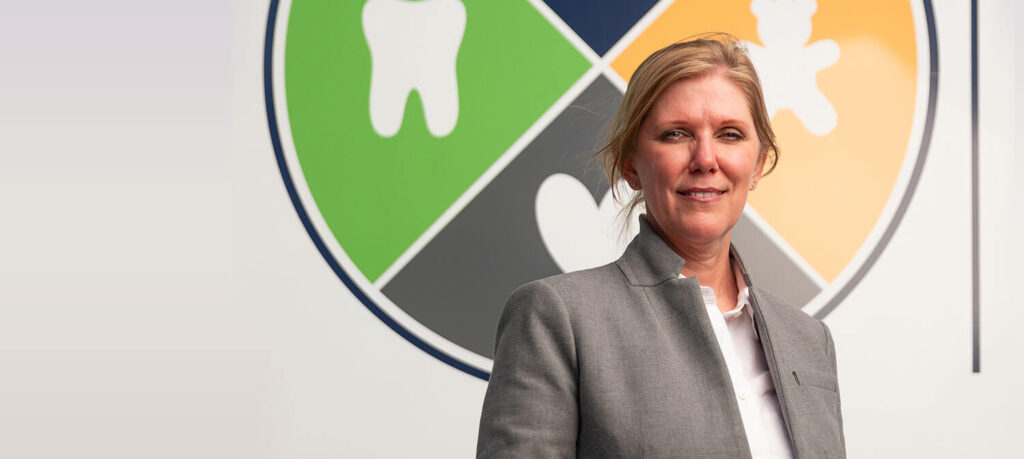
An Ardmore-based community health clinic provides more than just doctor’s visits to those seeking wellness.
Pick a card, any card.
This is how patients used to check into Good Shepherd, a doctor’s office converted from a small house in Ardmore, Oklahoma, in 1996. The living-room-turned-waiting-room was packed as each hopeful patient drew a playing card from a deck. When the cards ran out, so did appointments. Runny noses, fevers, coughs, troublesome toothaches — the kinds of needs not easily met by hourly wages — gathered 85 patients a week for a mere 52 slots.
For low income families unwilling to gamble on their health, the Good Shepherd free clinic was a sure bet. The clinic didn’t make money, so you wouldn’t see ads in the local paper. The medical staff, administrative support staff and board of directors were local volunteers. By word-of-mouth and grace, people flocked to Good Shepherd.
“We couldn’t be sustainable through grants alone, so we didn’t tell people what we did,” says Teresa Myers, CEO of Good Shepherd. “Our patients came to us from word-of-mouth. Good Shepherd was a best-kept secret.”
 The Good Shepherd Community Clinic became a federally recognized community health clinic to help fill a gap in rural medicine in 2014.
The Good Shepherd Community Clinic became a federally recognized community health clinic to help fill a gap in rural medicine in 2014.
Myers came to the organization after losing a family member to cancer in 2013. Her difficult journey as a caretaker gave her a new mission: to transform rural healthcare from a reactive system to a source of preventative care, wellness and connection for a whole community.
A grant writer position came open at Good Shepherd, and Myers applied. Nine months later, she was CEO.
“I had never run an organization in my life,” Myers says. “But I love Jesus a whole lot, and I felt that he pressed upon my heart and said, ‘Remember that thing you’re ticked off about? I’d like you to fix that, please.’ And I said, ‘I don’t know how to do that. I don’t know what I’m doing.’”
Myers and team began researching ways to do more. Becoming a charity clinic was the first step. The clinic, which is now known as the Good Shepherd Community Clinic (GSCC), started offering services at a small sliding scale to generate revenue and expanded services beyond common colds and tooth extractions. Volunteers became a paid, growing staff. For every 400 patients, the GSCC required a new exam room. For every 1,500 new patients, GSCC required another provider. Myers needed more space, more doctors and nurses, and more money.
 The Good Shepherd Community Clinic provides full dental, pharmaceutical, pediatric and women’s wellness services.
The Good Shepherd Community Clinic provides full dental, pharmaceutical, pediatric and women’s wellness services.
In 2014, GSCC moved to become a federally recognized community health clinic to help fill a gap in rural medicine. Low income families on Medicare and Medicaid must navigate a complicated road to health, Myers says. Deductibles are often impossible to meet on basic income, and access to providers is limited because private practices can’t afford to operate on Medicare or Medicaid reimbursements. But Good Shepherd can.
Along the way, The Samuel Roberts Noble Foundation, which had supported the clinic since it was established, provided funds to help GSCC as it increased its capacity to serve the community. In 2019, Noble gave $90,000 in operational support.
“The Noble Foundation allows us to keep our doors open,” Myers says. “We’re a service-based organization, which can make it difficult to find support. Many foundations want to see a project created or something new to give money to. But it’s people that do things. Noble has supported us so we can take care of others.”
Today the 32-person staff of doctors, dentists and wellness experts operate a $3 million budget to serve nearly 3,500 south-central Oklahoma patients annually. GSCC offers full dental and pharmaceutical services, pediatrics, and women’s wellness. Anyone, regardless of status or insurance, can become a patient.
“All of us together know we have a mission here, and the mission is bigger than any one of us,” Myers says. “One of the things we do best here is break down barriers. We don’t turn anybody away. When we do that, we can transform healthcare.”
 Noble Foundation has supported the clinic since it was established. In 2019, the organization gave $90,000 in operational support.
Noble Foundation has supported the clinic since it was established. In 2019, the organization gave $90,000 in operational support.
If you see someone walking down a rural road, you might mistake them for a hitchhiker. GSCC sees a different person: a cardiac patient, walking 17 miles to make an appointment at Good Shepherd.
Funding is about so much more than medical services, Myers says. Social factors like transportation, food, housing, literacy, mental health and addiction determine the health of a community. Through donations, grants, and ingenuity from staff and Ardmore’s medical community, patients are able to receive whole care — from a cab ride home to life-changing reconstructive surgery following a double-mastectomy.
This desire to build a healthier community, not just be a doctor’s office, has inspired GSCC’s goal to build a new wellness center accessible to everyone. In 2019, the Noble Foundation pledged $150,000 toward the $11 million project, which is expected to break ground in 2020. The center will feature a teaching kitchen, kid zone, outdoor playground and a walking track circling 4 acres.
 A new, $11 million wellness center will help build a healthier community with more space for the clinic in addition to a teaching kitchen, kid zone, outdoor playground and walking track.
A new, $11 million wellness center will help build a healthier community with more space for the clinic in addition to a teaching kitchen, kid zone, outdoor playground and walking track.
“There is nothing more important to our families and communities than our health,” says Stacy Newman, Noble Foundation program officer. “This one project will impact thousands of lives each year and better our communities in a meaningful way.”
Myers is excited for the future, including the possibility of a whole and healthy southern Oklahoma. The new wellness center is slated to open in 2021, just in time for GSCC’s 25th anniversary.
For now, Good Shepherd is in a modular building at a busy intersection in Ardmore. Nurses work in a crowded back hallway — some are filling out paperwork, others are studying for advanced certifications, and still others are hustling to get back to patients. University students are on clinical rotations and seeing public health at work for the first time.
“The goal of every nonprofit should be not to exist,” Myers says. “You solve polio. You eradicate cancer. Then you move on to the next thing. We build healthy people so they don’t need us.”
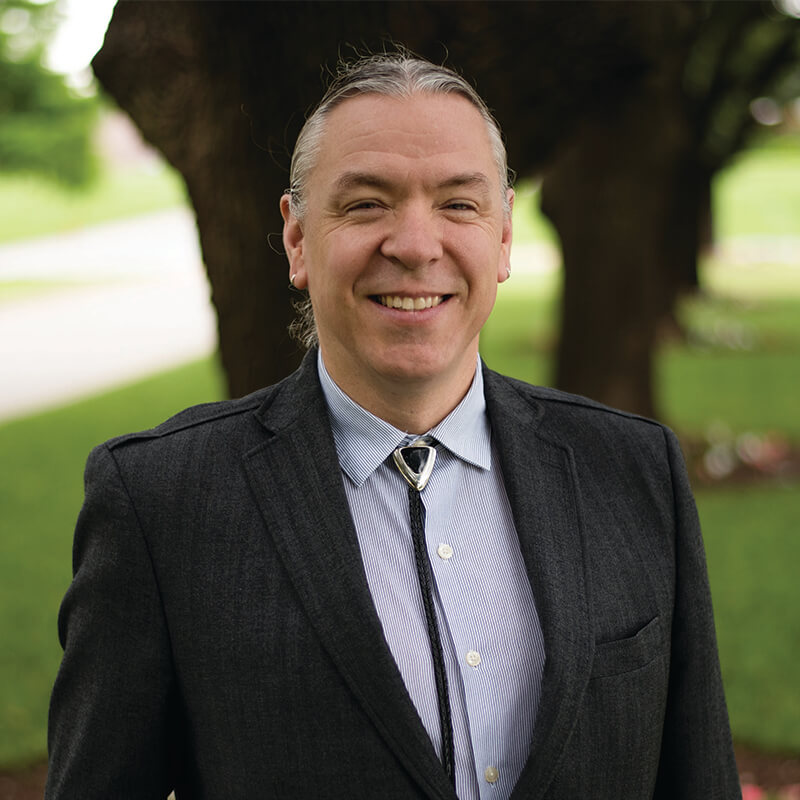
“Noble Foundation provides funding to help A Chance to Change continue programs to help Oklahomans live healthy, addiction-free lives.”
Stay up to date on all the ways the Noble Foundation is helping address agricultural challenges and supporting causes that cultivate good health, support education and build stronger communities.
Gene Waxman
on
November 14, 2023
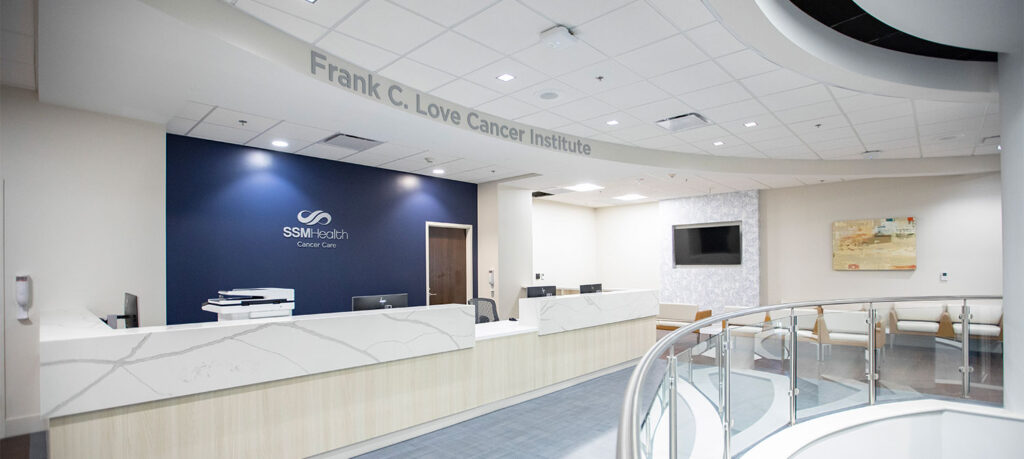
A $5 million expansion to the Frank C. Love Institute gives SSM Health St. Anthony Hospital greater opportunities to serve cancer patients from across Oklahoma.
When the expanded Frank C. Love Cancer Institute at SSM Health St. Anthony Hospital in Oklahoma City’s Midtown was dedicated on Valentine’s Day 2020, no one could predict that just a month later life as we knew it would turn on its head by COVID-19. For cancer patients at St. Anthony, however, there was a silver lining.
“If we hadn’t expanded before the pandemic, we wouldn’t have been able to treat all of our cancer patients because of the social distancing requirement,” recalls Sherry Rice Rhodes, vice president, philanthropy and foundation at the SSM Health St. Anthony Foundation. “It was a sobering thought.”
Before the $5 million expansion began in May 2019, the space dedicated to cancer patient care was located in the hospital’s basement. It was so crowded family members couldn’t always sit with their loved ones receiving treatments. There was no natural light because there were no windows. The thick concrete walls necessary to shield the radiation oncology department’s nearby treatment equipment resulted in spotty internet service or none at all.
“We literally were bursting at the seams,” Rhodes recalls. “We toyed with the idea of constructing a new building but decided that we’d rather keep the Cancer Institute here at the hospital so that if a patient needed other services, everything would be available to them right here. So we reconfigured space to accomplish that goal.”

The expansion relocated all medical oncology cancer services to the third floor, more than doubling the size from 6,400 square feet to 13,454 square feet. The new space has windows, natural light, internet service, a nourishment center, multiple bathrooms, space for 32 chemotherapy chairs in private and semi-private areas, and area for family members to sit comfortably with their loved ones. It also has a resource center, which provides compassion and support patients need on their treatment journey.
“It’s so much more uplifting,” Rhodes says. “People who have been diagnosed with cancer say your heart stops beating when you hear those words. To be in a space that is comforting and welcoming is important to their treatment and recovery.”
The Samuel Roberts Noble Foundation contributed $50,000 to the project. Since 1971 it has granted a total of $1,130,000 to the St. Anthony Hospital Foundation.
“The Samuel Roberts Noble Foundation’s granting program provides funding to charitable organizations that cultivate good health, as well as those supporting education and building stronger communities,” explains Stacy Newman, director of philanthropy for the Noble Foundation. “The recent grant to St. Anthony Hospital Foundation supporting the Frank C. Love Cancer Institute fulfilled the Foundation’s desire to improve health care of Oklahomans and support the growing need for cancer care to all families across our state.”
The American Cancer Society has estimated that 22,820 Oklahomans will receive the news they have cancer in 2021. The most common cancers in the state are lung and bronchus, breast, and prostate.
“‘Cancer’ is one of the scariest diagnoses to hear and the St. Anthony Foundation found a way to ease the anxiety of each patient by providing a space conducive to healing and comfort,” Newman adds. “People matter most at the Frank C. Love Cancer Institute, and the improvements allow them to provide compassionate and exceptional care during a difficult time.”

Jamie Farha is one of those people. Farha, who served as co-chair of the fundraising committee for the Cancer Institute expansion project, was thrilled the day it opened its doors in February 2020. But she never expected to walk through those doors six months later as a patient.
“In August 2020, I was diagnosed with breast cancer,” Farha explains. “The diagnosis didn’t make sense. I had never felt better in my life. I was at the top of my game. I went into shock and denial. In a single moment, I went from being a fundraiser for the Institute to being a patient at the Institute.”
There was no question that she would be treated at the Frank C. Love Cancer Institute.
“The physical changes — the space, the light, the happy environment — made a world of difference,” she says. “But what you’d never know if you didn’t journey the path as a patient is how beautiful the Institute’s team approach is. What they offered was way beyond the physical change. Their care, support and comfort allowed me to walk the path that so many cancer patients walk in arms that were so loving.”

Today, the Frank C. Love Cancer Institute is the second busiest in the Oklahoma City metropolitan area and serves patients from across the state. It currently provides services to 13.2% of Oklahomans seeking outpatient cancer treatment and 20.9% of those seeking inpatient oncology care.
“Our goal is to become the leading integrated cancer program, offering a full spectrum of clinical services, as well as prevention and wellness programs,” Rhodes says. “We care for our patients with an uncompromising commitment to clinical excellence and customer service.”
She adds that the expansion has allowed St. Anthony Hospital to serve a growing number of patients with additional oncologists and advanced equipment and technology.

“Patient growth is occurring through partnerships that include expansion of our telemedicine programs, growing our management agreements and partnerships with rural hospitals, increasing our rural outreach clinics and adding new health plexes,” Rhodes says. “Patient satisfaction, as measured by independent surveys, is continuously evaluated for action by clinical and executive staff. Currently, our oncology patients rank us in the top 2% in the nation for patient satisfaction.”
Farha, who completed her treatment in April, can attest to that high level of patient satisfaction.
“I think the reason I’m so passionate about St. Anthony is that they’re true to their mission: They will provide healthcare to anyone who comes here,” she says. “It’s a beautiful place to get the best medical treatment in the state of Oklahoma.”
Rhodes, who has spent the bulk of her career at the SSM Health St. Anthony Foundation, agrees.
“The Frank C. Love Cancer Institute is one more way we’re living out our mission every day,” she says. “Our hearts and our doors are open. We are firmly committed to that.”

Stay up to date on all the ways the Noble Foundation is helping address agricultural challenges and supporting causes that cultivate good health, support education and build stronger communities.